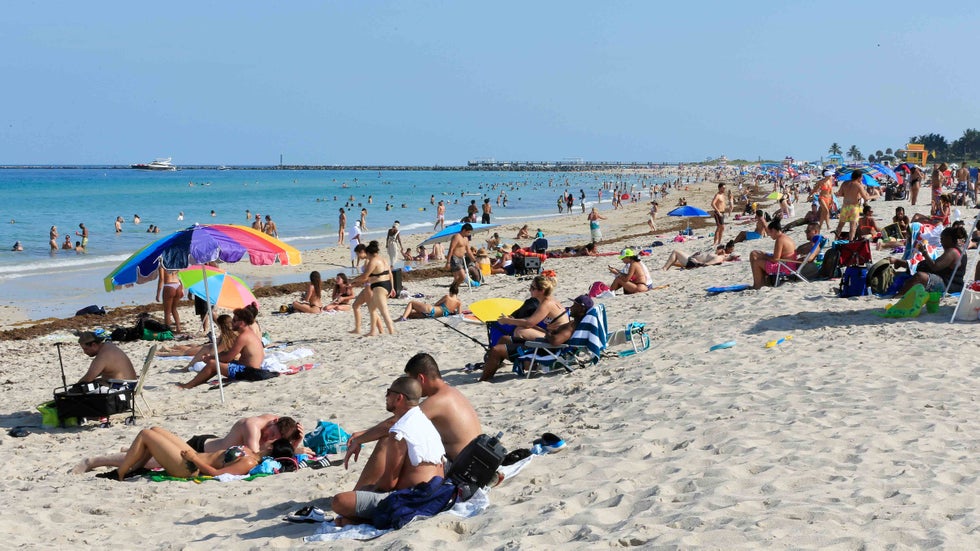 Beachgoers take advantage of the opening of South Beach on June 10 in Miami Beach, Florida. Miami-Dade county and the city of Miami reopened beaches as the area eases restrictions put in place to contain COVID-19.
Beachgoers take advantage of the opening of South Beach on June 10 in Miami Beach, Florida. Miami-Dade county and the city of Miami reopened beaches as the area eases restrictions put in place to contain COVID-19.Summer typically means an increase in outdoor activities and combined with summer weather this can lead to dangerous conditions.
Let's take a look at some of the hazards that summer weather can bring and what you need to do to stay safe.
Remember Lightning Safety
Lightning is four times hotter than the sun, and the safest place to be during a thunderstorm is inside a building or in a hard-topped vehicle.
When you see lightning, get to a safe place as soon as possible and remain there until 30 minutes after the last rumble of thunder before going outdoors.
Many are caught off-guard in the summer by pop-up thunderstorms. Most lightning deaths occur outside and are related to water or sports. June, July and August have been the deadliest for lightning from 2010-19.
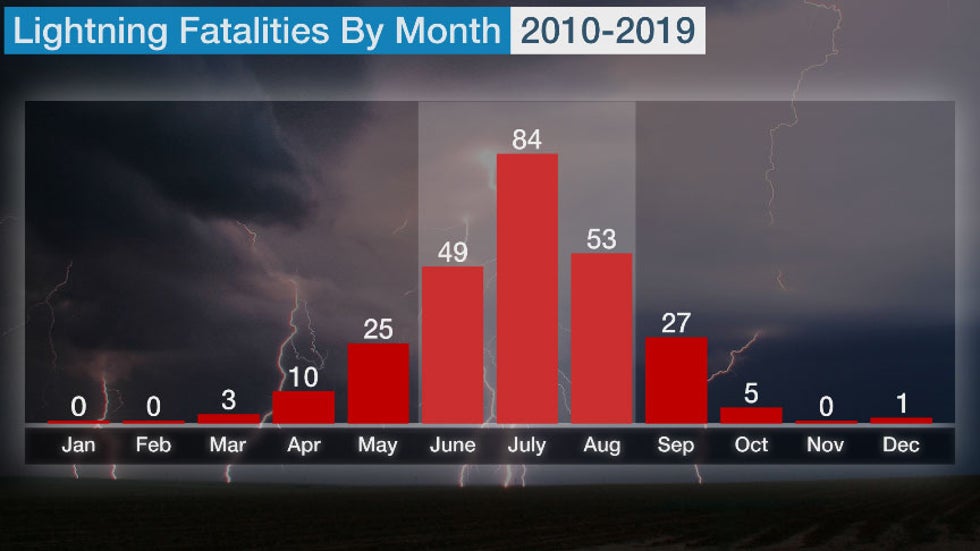 Lightning Fatalities By Month From 2010-19
Lightning Fatalities By Month From 2010-19The odds of being struck by lightning in your lifetime are 1 in 15,300, but the odds of being struck in a given year are just 1 in 1,222,000, according to the National Weather Service (NWS).
Lightning can strike up to 15 miles from the parent thunderstorm, so remember to pay attention to the weather and when thunder roars, head indoors. Also, have a plan if you will be far from shelter or boating.
Heat Illnesses and Sunburn Can Ruin Fun in the Sun
More people die from heat than any other weather conditions in the U.S., on average. Each year, 136 people die from heat, based on the 1989-2018 average, according to the NWS.
Everyone should take extreme heat seriously, but this is especially true for children, the elderly and those with health issues.
The first signs of heat illness are increased sweating and muscle cramps. This can evolve into heat exhaustion or heat stroke and possibly death if treatment is not received.
If you start to exhibit symptoms of heat illness, get out of the heat, drink nonalcoholic and decaffeinated beverages, take a cool shower and rest.
(MORE: Four Things Extreme Heat Does To Your Body)
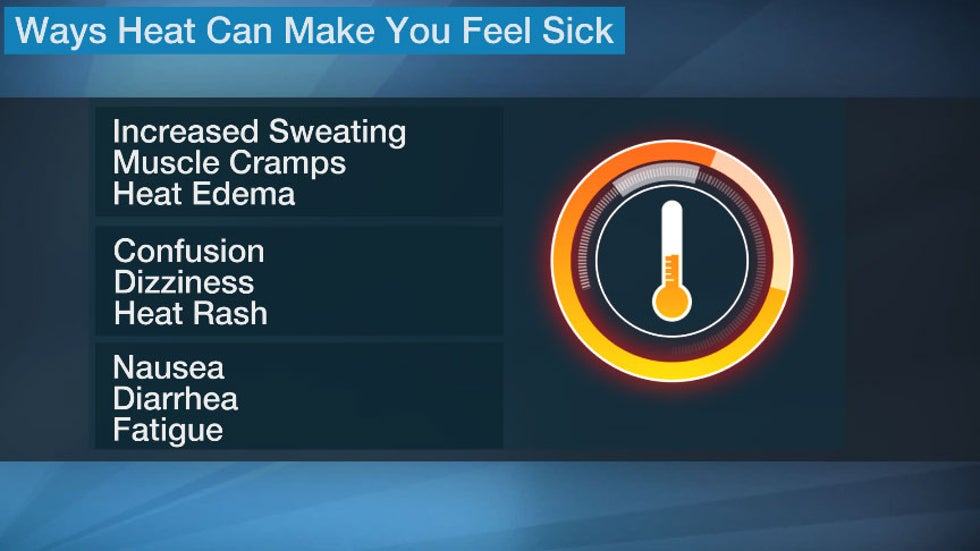
Sunburn and overexposure to ultraviolet (UV) radiation are additional concerns. Too much sun can lead to a first- or second-degree burn and possibly skin cancer.
(MORE: The UV Index: How Much Is Your Skin In Danger?)
To minimize your risk of heat illness and skin damage:
- Limit exposure to the sun during the middle of the day, from 10 a.m. to 4 p.m.
- Use a sunscreen of SPF 30 or higher and apply 30 minutes prior to exposure and reapply every two hours.
- Wear protective, lightweight and light-colored clothing, including a wide-brimmed hat and UV-blocking sunglasses.
- Take frequent breaks.
- Drink more water than usual, even if you don't feel thirsty.
Warm temperatures help ground-level ozone form and that can result in poor air quality. Those who suffer from respiratory disease can be at risk. The EPA recommends that strenuous outdoor activity be limited on days with unhealthy air quality.
Turn Around, Don't Drown
Flash flooding is another danger that is more frequent in the summer. NOAA's Weather Prediction Center noted that 75 percent of all flash flood reports in the U.S. occurred from late April through mid-September, and 34 percent occurred from June 10-August 3, based on data from 2007-2017.
Flash flooding refers to short-term flood events triggered by heavy rainfall over a relatively small area.
There are several reasons flash flooding becomes more common in the summer. Warmer temperatures and an increase in moisture can combine with a slow-moving system in the summer, resulting in heavy rainfall in a short period of time. Thunderstorm clusters can also develop and trigger flash flooding.
(MORE: We're Heading Into Prime Time for Flash Flooding in the U.S.)
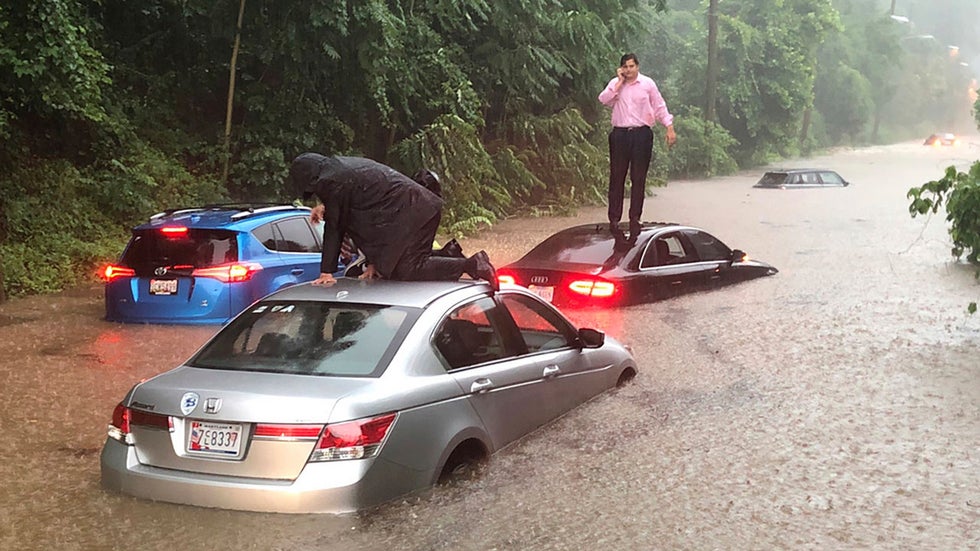 Motorists are stranded on a flooded section of Canal Road in Washington D.C. during a heavy rainstorm, Monday, July 8, 2019.
Motorists are stranded on a flooded section of Canal Road in Washington D.C. during a heavy rainstorm, Monday, July 8, 2019.In addition, the Southwest monsoon can bring slow-moving thunderstorms that dump torrential rainfall and tropical cyclones or their remnants can also bring serious flash flooding.
To stay safe during a flash flood event:
- Do not drive into a flooded area.
- If floodwaters are near your vehicle, abandon it and move to higher ground immediately.
- Know that 6 inches of water can cause loss of control of a car and cause it to stall.
- Cars can float in 12 inches of water and 24 inches can sweep your vehicle away.
Do not try to wade through floodwater. Just 6 inches of water can knock a person off their feet.
The best advice is to be aware of weather conditions, which can change rapidly.
Rip Currents, High Surf and Waterspouts Are Concerns at the Beach
Rip currents are one of several hazards to be aware of at the beach. Rip currents are strong but narrow currents that flow away from shore.
More than 80% of rescues performed by surf beach lifeguards are due to rip currents. Rip currents cause more than 50 deaths each year, based on the 2009-2018 average.
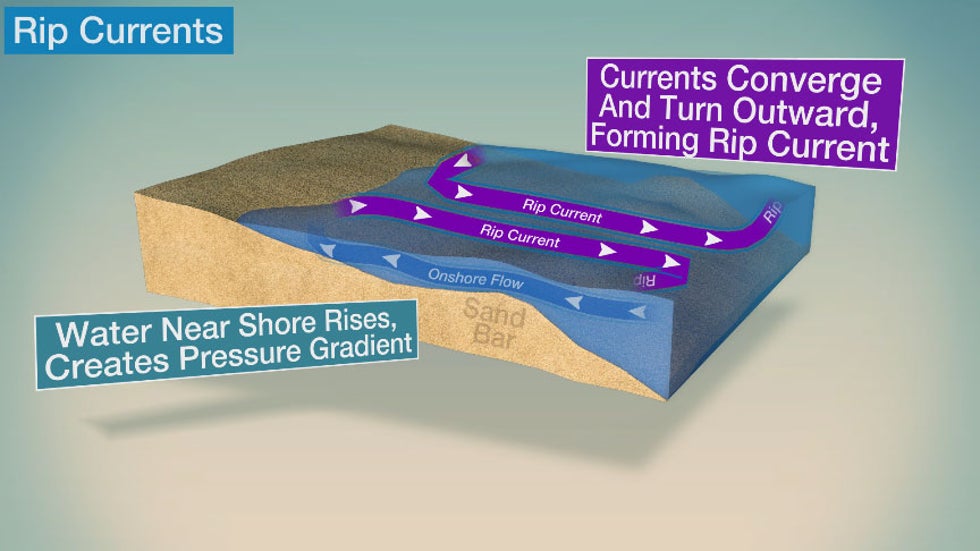
Significant rip currents are more likely when a strong onshore wind is present. Water in a rip current is generally darker than surrounding waters and are areas where waves do not break.
If you are caught in a rip current, swim parallel to the shore and back to land at an angle. If you cannot swim out of it, float or calmly tread water until you are out of the rip current.
High surf can also be dangerous, as large waves can catch beachgoers off guard, so don't turn your back on the ocean. Dangerous swimming conditions are also usually present in high surf.
Waterspouts are another concern to watch for at the beach. Waterspouts are tornadoes that develop over water and can develop with a thunderstorm or in fair weather.
Fair-weather waterspouts typically stay over water and move fairly slow, while those associated with thunderstorms can move onshore.
Always be aware of weather conditions, water conditions and the risk for rip currents.
The Weather Company’s primary journalistic mission is to report on breaking weather news, the environment and the importance of science to our lives. This story does not necessarily represent the position of our parent company, IBM.
The Weather Company’s primary journalistic mission is to report on breaking weather news, the environment and the importance of science to our lives. This story does not necessarily represent the position of our parent company, IBM.

No comments:
Post a Comment